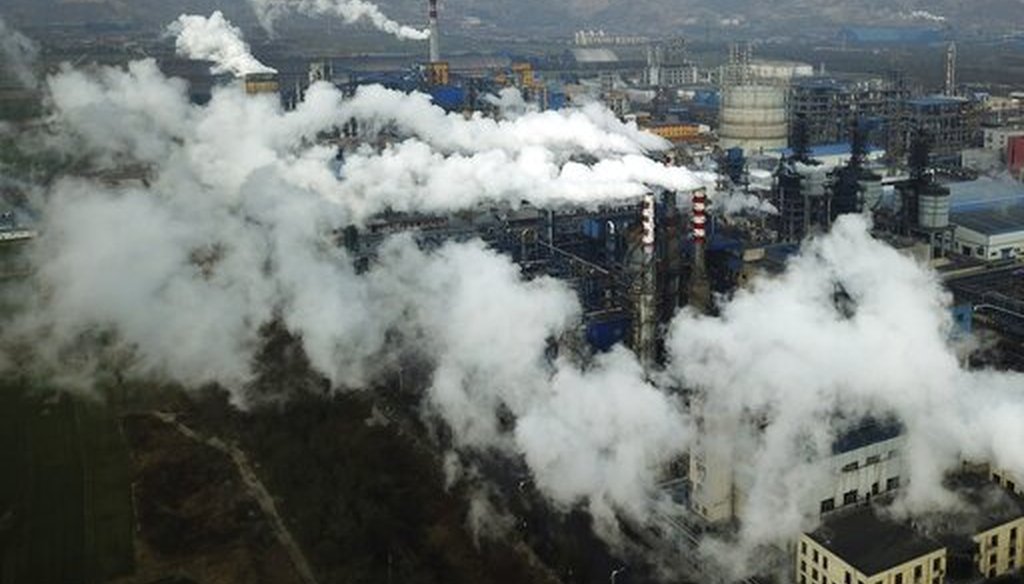Stand up for the facts!
Our only agenda is to publish the truth so you can be an informed participant in democracy.
We need your help.
I would like to contribute

In this Nov. 28, 2019 file photo, smoke and steam rise from a coal processing plant in Hejin in central China's Shanxi Province. (AP)
If Your Time is short
-
Both the U.S. and China are the world’s largest emitters of carbon dioxide — the U.S. in all-time total and per person per year, and China annually.
-
The U.S. is reducing CO2 emissions, while China’s are rising. China is leading on developing renewable energy.
-
Whatever China does, experts said, the U.S. and the world would benefit if the U.S. keeps working to lessen climate change.
China and the United States could share the carbon dioxide emissions crown.
China is, by far, the world’s largest emitter of carbon dioxide, putting more than twice as much into the air each year as the U.S. does. But per person, the U.S. emits twice as much carbon dioxide as China does.
These emissions trigger global warming and "global weirding" — a term some scientists use to describe deadly and costly extreme weather events occurring more often.
But people polled around the globe and U.S. politicians in particular say that China isn’t doing its fair share to combat climate change. In 2021, at a G20 summit in Rome, President Joe Biden said China "basically didn’t show up in terms of any commitments to deal with climate change." The Republicans’ House climate caucus has said, "China is the greatest immediate obstacle to reducing world emissions."
Which raises the question: If there’s a perception that China isn’t doing enough to lessen climate change, why should the U.S. continue its efforts? Experts say comparing the nations’ climate mitigation isn’t apples-to-apples for several reasons.
Let’s look at three key points:
1. Whether China or the U.S. holds the title of world leader in carbon emissions depends on how you measure. China leads in annual emissions, but the U.S. is the all-time leader and the current annual leader in per-person emissions.
2. The U.S. is reducing its CO2 emissions while China’s are increasing — but China leads on renewable energy.
3. Regardless of what China does, the world and the U.S. benefit from U.S. efforts to reduce CO2 emissions, experts said.
Not continuing climate change efforts is "cutting off your nose to spite your face," because it would cause more hurricanes, floods and other extreme events, said Michael Oppenheimer, a Princeton University professor of geosciences and international affairs.
"These events are going to keep coming at us like a sequence of bowling balls, and we’re the pins," Oppenheimer told PolitiFact. "They’re going to come down that alley faster and faster, more and more frequently, and we haven’t been thinking enough about how we’re going to deal with that."
Greenhouse gases, notably carbon dioxide, are produced when fossil fuels such as coal and oil are burned for energy. When these gases build up in the atmosphere, most scientists say, they trap heat and raise surface temperatures, leading to changes in climate such as climbing sea levels.
As of 2021, according to the latest figures, no country had emitted more carbon dioxide since 1850 than the U.S., and the U.S. total is nearly double China’s.
The U.S. has emitted 20% of the world’s CO2, and China 11%, according to Carbon Brief, a website that covers climate science. That’s 509 gigatons of carbon dioxide by the U.S. and 258 gigatons by China.
One gigaton — or 1 billion tons — is about 200 million elephants, enough to stretch from the Earth to the moon, according to a website run by University of Calgary energy professor Jason Donev.
Historical totals are important "because climate change increases in direct proportion with cumulative global emissions," said Simon Evans, a deputy editor at Carbon Brief.
The U.S. is also first and China second in annual carbon emissions per capita.
But in raw numbers, China is the largest annual emitter, producing twice as much CO2 each year as the U.S., which is second.
China’s annual emissions are rising, and U.S. emissions are falling. From 2005 to 2020, U.S. carbon dioxide emissions fell by 970 million metric tons; China’s increased by 4.6 billion metric tons.
Source: Our World in Data
China "may look as if they’re just chugging ahead in terms of emissions growth, and they are the world’s greatest emitter, by far," Oppenheimer said. "But they have also made substantial efforts to slow that growth."
China’s climate change contributions are vexing people in other nations, two polls released in 2021 suggest.
Across 17 developed nations, a median of 78% of respondents in a Pew Research Center poll described China’s handling of climate change as "bad." By contrast, a cumulative median of 61% respondents judge the American response as "bad."
In the U.S., 36% of Republican voters said no when asked if the U.S. should take ambitious actions on climate even if China doesn’t, compared with 16% of Democrats. The poll was sponsored by the Asia Society Policy Institute, a think tank.
The U.S. has taken substantial action on climate change, even if perspectives differ on whether it’s sufficient.
Biden’s Inflation Reduction Act directed an unprecedented $369 billion to move toward steep reductions in greenhouse gas emissions. His infrastructure law spends billions on measures such as public transit, electric grid upgrades and electric vehicle charging stations.
But comparing the U.S. with China on mitigating climate change is apples and oranges because relatively speaking, the U.S. economy has been industrially developed much longer than China’s, experts said.
"Yeah, they’ve got to do more," Oppenheimer said of China, "but a straight-on comparison to what the U.S. is doing isn't particularly valid."
The U.S. arguably should be doing more to reduce emissions than it has been because it has emitted the most carbon dioxide historically, said Robert Brecha, a professor of physics and renewable and clean energy at the University of Dayton. And China’s economy, while massive, is smaller than the U.S. economy, he said.
China continues to build coal-fired plants. The coal power capacity that started construction in China in 2022 was six times as large as that in all of the rest of the world combined, according to a February report by the Helsinki-based Centre for Research on Energy and Clean Air.
Coal power plants produce a fifth of global greenhouse gas emissions, more than any other single source, according to the International Energy Agency.
However, China also spent $546 billion, nearly half the global total in 2022, on "low-carbon energy transition," according to the research company BloombergNEF. The U.S. was at $141 billion.
The transition includes investments in renewable energy, energy storage, electrified transport and heat, and carbon capture and storage, BloombergNEF said.
The United Nations’ Intergovernmental Panel on Climate Change, in a report March 20, said "human activities, principally through emissions of greenhouse gases, have unequivocally caused global warming," and that emissions have continued to increase and will cause more global warming.
"Climate change is a threat to human well-being and planetary health. There is a rapidly closing window of opportunity to secure a liveable and sustainable future for all," the report said.
Experts said that regardless of what China does, it’s important for the U.S. to continue to reduce its emissions because of its impact on the climate and its influence on other countries.
"This idea that the U.S. shouldn’t be doing anything because China is not doing enough — every fraction of a degree of warming that we avoid is crucial," Brecha said. Within reasonable economic restraints, he said, "there's essentially no action to take that’s not worthwhile doing."
If the U.S. fails to lead on climate change, said Evans, "it becomes that much harder to persuade others to do so."
Oppenheimer urged cooperation.
"We’ll never get anywhere with just finger-pointing," he said.
RELATED: What does extreme weather tell us about climate change?
RELATED: Is the Paris Climate Agreement easier on China and India than on the US?
RELATED: Climate change fact-checks
Our Sources
PolitFact, "Is the Paris Climate Agreement easier on China and India than on the US?", Jan. 26, 2021
PolitFact, "China and India’s carbon dioxide emissions, in context," Dec. 2, 2021
PolitFact, "False image overstates pollution by China," Jan. 2, 2020
PolitFact, "Mitch McConnell says U.S.-China climate deal means China won't have to do anything for 16 years," Nov. 19, 2014
PolitFact, "What does extreme weather tell us about climate change?", Aug. 10, 2021
PolitFact, "Does the US lead in cutting greenhouse gases? It depends on how you look at it," April 6, 2022
Politico, "GOP's newest attack on Biden’s climate law: China," Feb. 13, 2023
New York Post, "Why destroy our economy to cut emissions — when China and India are spewing away?", Oct. 26, 2021
Our World in Data, "Per capita CO₂ emissions," accessed March 2, 2023
Our World in Data, "Annual CO2₂ emissions," accessed March 13, 2023
Our World in Data, "Share of global cumulative CO₂ emissions, 2021," accessed March 14, 2023
Email, Hannah Ritchie, Our World in Data deputy editor and science outreach lead, March 14, 2023
EnergyEducation.ca, "Gigatonne," accessed March 20, 2023
Email, Simon Evans, Carbon Brief deputy editor and policy editor, March 9, 2023
BloombergNEF, "Global Low-Carbon Energy Technology Investment Surges Past $1 Trillion for the First Time," Jan. 26, 2023
Associated Press, "Carbon dioxide emissions rising globally, but drop in China," Nov. 13, 2022
Politico, "New U.S. message on climate change: Make China pay," Nov. 5, 2022
Politico, "World to China: Time to step up on climate," Feb. 9, 2022
Asia Society Policy Institute, "Understanding American Voter Attitudes Toward U.S.-China Climate Cooperation," (Figure 2) February 2021
Pew Research Center, "In Response to Climate Change, Citizens in Advanced Economies Are Willing To Alter How They Live and Work," Sept. 14, 2021
Earth System Science Data (peer-reviewed journal), "Global Carbon Budget 2022," Nov. 11, 2022
Centre for Research on Energy and Clean Air, "China permits two new coal power plants per week in 2022," Feb. 27, 2023
Interview, Michael Oppenheimer, professor of geosciences and international affairs at Princeton University, March 10, 2023
Interview, Robert Brecha, professor of physics and renewable and clean energy, University of Dayton, March 13, 2023
The World Bank, "GDP per capita (current US$) - China, United States," accessed March 13, 2023
Washington Post, "How China, the world’s top polluter, avoids paying for climate damage," Nov. 23, 2022
Washington Post, "The United States has caused the most global warming. When will China pass it?", March 1, 2023
International Energy Agency, "World Energy Investment 2022: Overview and key findings," June 22, 2022
International Energy Agency, "It’s critical to tackle coal emissions," Oct. 8, 2021
Intergovernmental Panel on Climate Change, "Synthesis Report Of The Ipcc Sixth Assessment Report (AR6)," March 20, 2023
















